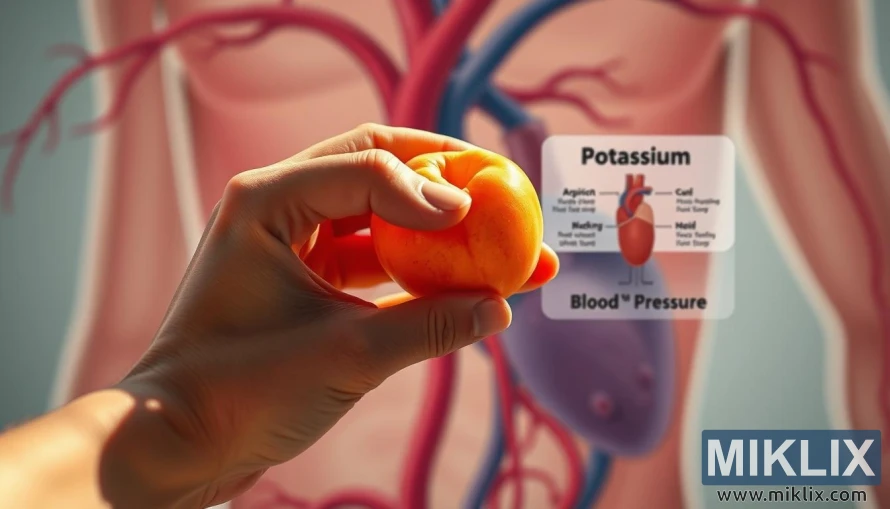Image: Apricots and blood pressure health
Published: May 22, 2025 at 8:43:46 AM UTC
Last updated: September 26, 2025 at 7:07:34 AM UTC
Close-up of a hand holding a potassium-rich apricot with blood vessels and a medical diagram in the background, highlighting its role in regulating blood pressure.
The image creates a powerful and visually engaging intersection between the natural nourishment of fruit and the inner workings of the human body, focusing specifically on the cardiovascular system. At the center of the composition, a human hand holds a perfectly ripe apricot, its golden-orange skin glowing under the warmth of natural light. The fingers cradle the fruit delicately, highlighting its smooth yet subtly textured surface, as if emphasizing not just its physical form but also its symbolic importance as a vessel of health. The play of light and shadow across both the hand and the apricot creates a sense of depth and realism, reinforcing the tangible connection between the food we consume and the effects it has within our bodies. The apricot, humble in appearance yet rich in nutrients, becomes the focal point of a larger narrative about vitality and wellness.
Behind this foreground, the background expands into a stylized medical illustration of the human cardiovascular system. Prominent blood vessels and arteries stretch across the scene, their branching networks evoking the complexity and fragility of the circulatory system. Shades of red and blue dominate this backdrop, visually representing oxygenated and deoxygenated blood as it courses through the body. The anatomical imagery is not overly clinical but rather interpretive, designed to suggest rather than overwhelm, providing enough clarity to anchor the message while still allowing the apricot to remain the hero of the composition. It reminds viewers of the invisible yet essential processes occurring within their own bodies, processes that can be directly influenced by something as simple as dietary choices.
In the middle ground, floating clearly within view, is a small medical diagram focused on the role of potassium in regulating blood pressure. This overlay, simple in design but rich in implication, links the apricot directly to heart health. With clean, informative labels, it illustrates how potassium helps relax blood vessel walls, supports proper heart function, and reduces the strain that elevated sodium levels can place on the body. The diagram serves as both a visual anchor and an educational tool, transforming the image from a mere still life into a holistic blend of nutrition and science. The juxtaposition of fruit and anatomy highlights the apricot as more than a sweet, seasonal delight; it is depicted as a natural ally in maintaining cardiovascular health.
The softly blurred gradient in the far background lends the entire scene an aura of warmth and cohesion. Its muted tones echo the natural palette of skin and blood, tying the medical illustration seamlessly with the organic subject matter in the foreground. This layering effect not only guides the viewer’s gaze but also enhances the symbolic weight of the apricot itself, situating it directly within the broader context of human health. The overall effect is one of harmony between science and nature, emphasizing that the foods we choose are not merely sources of energy but active participants in shaping our long-term well-being.
Together, the hand, the apricot, and the anatomical imagery tell a story of interconnectedness. The act of holding the fruit becomes emblematic of taking health into one’s own hands, a conscious decision to nourish the body in ways that protect and sustain it. The message resonates clearly: something as small and ordinary as an apricot can play an extraordinary role in supporting cardiovascular balance, lowering blood pressure, and promoting vitality. In this way, the composition elevates the everyday act of eating into a meaningful, almost profound gesture, reminding us that wellness is built one choice at a time, one nutrient at a time, one fruit at a time.
The image is related to: Small Fruit, Big Impact: The Power of Apricots for Your Health

